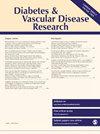The role of high mobility group box-1 on the development of diabetes complications: A plausible pharmacological target
IF 3
4区 医学
Q3 ENDOCRINOLOGY & METABOLISM
引用次数: 0
Abstract
BackgroundDiabetes mellitus has emerged as a pressing global concern, with a notable increase in recent years. Despite advancements in treatment, existing medications struggle to halt the progression of diabetes and its associated complications. Increasing evidence underscores inflammation as a significant driver in the onset of diabetes mellitus. Therefore, perspectives on new therapies must consider shifting focus from metabolic stress to inflammation. High mobility group box (HMGB-1), a nuclear protein regulating gene expression, gained attention as an endogenous danger signal capable of sparking inflammatory responses upon release into the extracellular environment in the late 1990s.PurposeGiven the parallels between inflammatory responses and type 2 diabetes (T2D) development, this review paper explores HMGB-1’s potential involvement in onset and progression of diabetes complications. Specifically, we will review and update the understanding of HMGB-1 and its inflammatory pathways in insulin resistance, diabetic nephropathy, diabetic neuropathy, and diabetic retinopathy.ConclusionsHMGB-1 and its receptors i.e. receptor for advanced glycation end-products (RAGE) and toll-like receptors (TLRs) present promising targets for antidiabetic interventions. Ongoing and future projects in this realm hold promise for innovative approaches targeting HMGB-1-mediated inflammation to ameliorate diabetes and its complications.高迁移率基团框-1 在糖尿病并发症发展中的作用:一个可信的药理靶点
背景糖尿病已成为全球亟待解决的问题,近年来发病率明显上升。尽管治疗手段不断进步,但现有药物仍难以阻止糖尿病及其相关并发症的发展。越来越多的证据表明,炎症是糖尿病发病的重要驱动因素。因此,新疗法的视角必须考虑将重点从代谢压力转移到炎症。高迁移率基团框(HMGB-1)是一种调节基因表达的核蛋白,作为一种内源性危险信号,它在释放到细胞外环境时能够引发炎症反应,这一点在 20 世纪 90 年代末引起了人们的关注。目的鉴于炎症反应与 2 型糖尿病(T2D)发病之间的相似性,本综述论文探讨了 HMGB-1 在糖尿病并发症的发病和进展中的潜在参与。结论HMGB-1 及其受体,即高级糖化终产物受体(RAGE)和收费样受体(TLRs),是抗糖尿病干预的有希望的靶点。该领域正在进行和未来将开展的项目为针对 HMGB-1 介导的炎症改善糖尿病及其并发症的创新方法带来了希望。
本文章由计算机程序翻译,如有差异,请以英文原文为准。
求助全文
约1分钟内获得全文
求助全文
来源期刊

Diabetes & Vascular Disease Research
ENDOCRINOLOGY & METABOLISM-PERIPHERAL VASCULAR DISEASE
CiteScore
4.40
自引率
0.00%
发文量
33
审稿时长
>12 weeks
期刊介绍:
Diabetes & Vascular Disease Research is the first international peer-reviewed journal to unite diabetes and vascular disease in a single title. The journal publishes original papers, research letters and reviews. This journal is a member of the Committee on Publication Ethics (COPE)
 求助内容:
求助内容: 应助结果提醒方式:
应助结果提醒方式:


